Why Ganesha is worshipped first | Hindu god worshipped before beginning a new work | What can we get after Ganesh worship | Why is Ganesha important | Who is first worshipped among Gods
Namaste friends, how are you doing today? Welcome to #BhagavanBhakthi website / blog.
Bhagavan Lord Sri Krishna (Lakshmi Narasimha) (Vitthal) (Vishnu) (Rama) (Trivikrama) and Goddess Sri Rukmini (Lakshmi), Lord Shiva, Goddess Parvati and Lord Ganesh blessings to you and your family!
In this website / blog, you will always learn about #Hinduism #Sanskrit language.
Also subscribe to my YouTube channel from this link #BhagavanBhakthi to view videos about #Hinduism #Sanskrit language.
Just before going to “Why Ganesha is worshipped first | Hindu god worshipped before beginning a new work | What can we get after Ganesh worship | Why is Ganesha important | Who is first worshipped among Gods“, let us know a brief, basic and very important information.
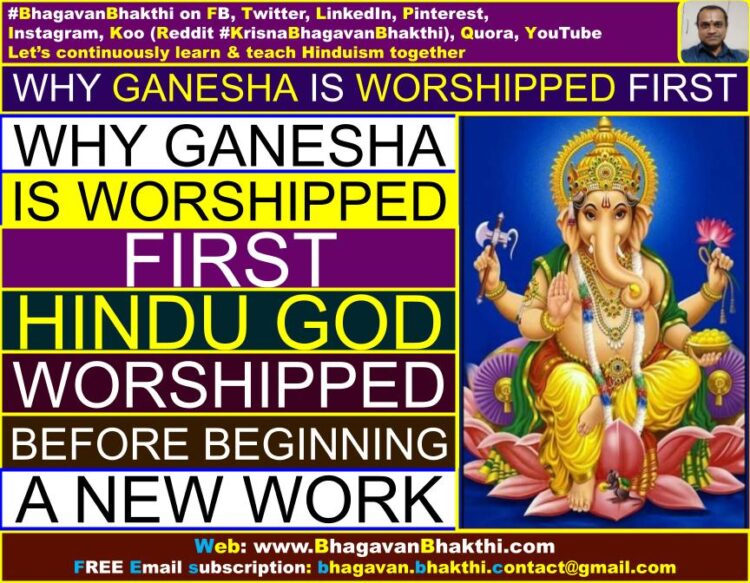
Just before moving forward let us first understand the meaning of the word Ganesha:
Meaning of the name (word) Ganesha is as given here: Ganesha = Gana + Isha – Here Gana means, a group of Devatas (Demigods) who live in Kailasa (Kailash) and are a happy group of Devatas (Demigods) who love to serve Lord Shiva and Goddess Sri Parvati Devi.
Note : Most of the people are completely dependent on TV serials, movies and cartoons to know about Hinduism, Hindu Gods including Lord Ganesha. But these media never show the reality and only show the content that brings them money.
In this post (article) you will know the true stories taken from various Puranas (Hindu Texts) and the author of this post (article) requests all readers to read the full post (article) to know complete and correct information about Lord Ganesha according to Hindu Puranas (Texts).

Now, let us know “Why Lord Ganesh is worshipped first” in detail as given below:
Isha means, someone who is leading a group. Thus full meaning of the name Ganesha is that – someone who is leading a group of Demigods whose names as Ganas in Kailasha.
As a Dharmic Vedic God, presence of Lord Ganesha has been felt in all cosmic ages and has been eulogized in many Vedic scriptures.
While several puranic scriptures like: Shiva Purana, Skanda Purana, Brahma Vaivarta Purana etc. have made reference of Lord Ganesha. Also similarly specific ‘upapuranas‘ (sub Puranas) that is, Ganesha Purana, Mudgala Purana (both are Upa Puranas) are exclusively dedicated to Lord Ganesha.
As said above, as a leader of all the Ganas (divine group at Kailasha), Ganesha is believed to be a personification of ‘Omkaram‘ and considered as one of the main Demigods as per the Vedic Dharma.
Even though Lord Ganesha is a Demigod, he has been conferred with an unique prominence as a potent God to be worshipped, before worshiping any other God or Goddess.

Lord Ganesha is one of the greatest bhakta / devotee of Lord Sri Vishnu. Lord Ganesha was born to Goddess Sri Parvathi Devi with the blessings of Lord Sri Vishnu himself. Lord Ganesha is worshiped as ‘Vishnu Parivara devata‘ (one of the member of Lord Sri Vishnu’s family members).
To know the full story of the birth of Lord Ganesha, you can visit this below link:
Lord Ganesha birth correct story
As per the Sanatana Dharma, Lord Ganesha is the ‘abhimani devata‘ (chief controlling Demigod) of Aakasha (sky / space) as a form of ‘Vishwambharamurti‘ (विश्वंभरमूर्ति / ವಿಶ್ವಂಭರಮುರ್ತಿ / viśvambharamurti).
Lord Ganesha is the Bhagavan Sri Vishnu’s ‘Vishwa Taijasa Roopa‘, that is – someone who controls the waking (jagrat) and dreaming (swapna) state of ‘Jeevas‘ (livings beings) is an adorable Demigod.
Worship of Lord Ganesha is going on and is prevailing in Hindu Sanatana Dharma since time immemorial. Maybe, perhaps since Vedic times. In Hindu Sanatan Dharma there are several historical and Puranic references to the worship of Lord Ganesha.
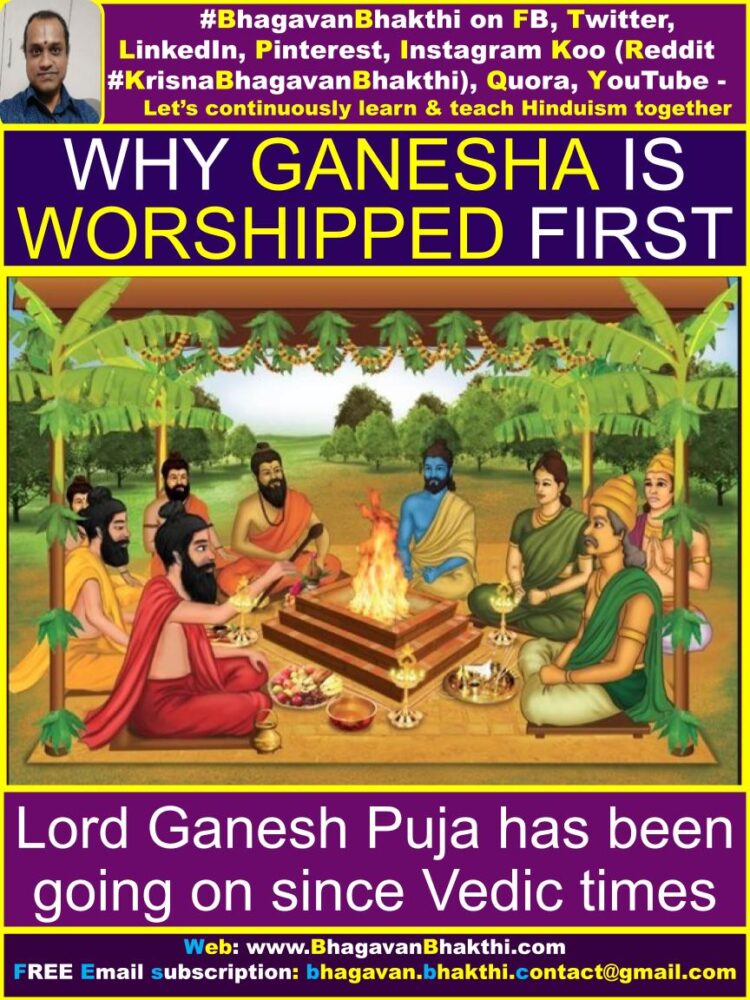
We can easily find out several divine personalities including ‘Tridevas‘, that is, ‘Trinal Lords‘ (Lord Brahma, Lord Sri Vishnu, Lord Shiva) having worshiped Lord Ganesha on different occasions for various reasons.
Lord Sri Vishnu mainly in his incarnations as Lord Sri Rama and Lord Sri Krishna worshiped Lord Ganesha for ‘Loka Kalyana‘
[To make understand and for the welfare of the mankind) and also to maintain the ‘Loka reeti‘ (acceptable by all).]
Also, Lord Ganesha has played a highly significant and very important roles in the origins of famous ‘Teertha Kshetras‘ (pilgrimage) of Lord Shiva.
For example: In the places like ‘Gokarna‘ (Karnataka) (This is regarding the ‘Aatma Linga Kshetra‘ of Lord Shiva) and that of Lord Sri Ranganatha Swamy at Sri Rangam near Trichy in Tamil Nadu.
To know the story of the Lord Shiva’s ‘Aatma Linga Kshetra‘, and how significantly Lord Ganesha played a very important role in the establishment of the Gokarna ‘Aatma Linga‘ of Lord Shiva, you can visit this below link:
Significance of Gokarna – The three Shiva Linga
We should also note that, Lord Ganesha was also associated with Rishi / Sage Lord Sri Veda Vyasa Ji (he is an avatar of Bhagavan Sri Vishnu) in scripting the greatest epic on earth called ‘Mahabharata‘.
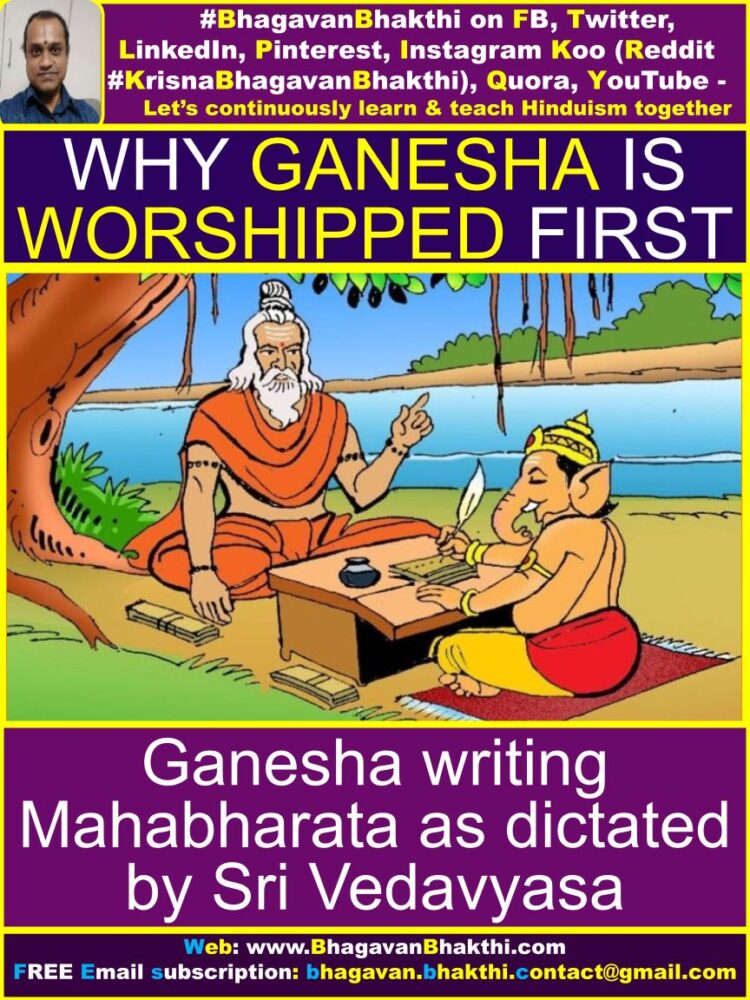
Also we should understand that, Lord Ganesha is the one who has shown to the world the significance of parents by doing ‘pradakshina‘ / ‘parikrama‘ / circumambulation around Lord Shiva and Goddess Parvati Devi.
Lord Ganesha does this, by chanting ‘Narayana mantra‘ that has bestowed Lord Ganesha the position of ‘Ganadhipatya‘, that is, Lordship over all the ‘Ganas‘.
To know the full story of ‘Ganesha Kartikeya race correct story‘, you can visit the below link for more information:
Ganesha Kartikeya race correct story
Also, Lord Ganesha is the lord of vidya / education and patron of letters is one of the best known and most widely worshipped Devata of Hindu Sanatana Dharma. From north to south and from west to east from all walks of people worship Lord Ganesha regardless of any belief.
Lord Ganesha, as the Lord of wisdom and knowledge (discriminative) Lord Ganesha helps in overcoming the negative passions.
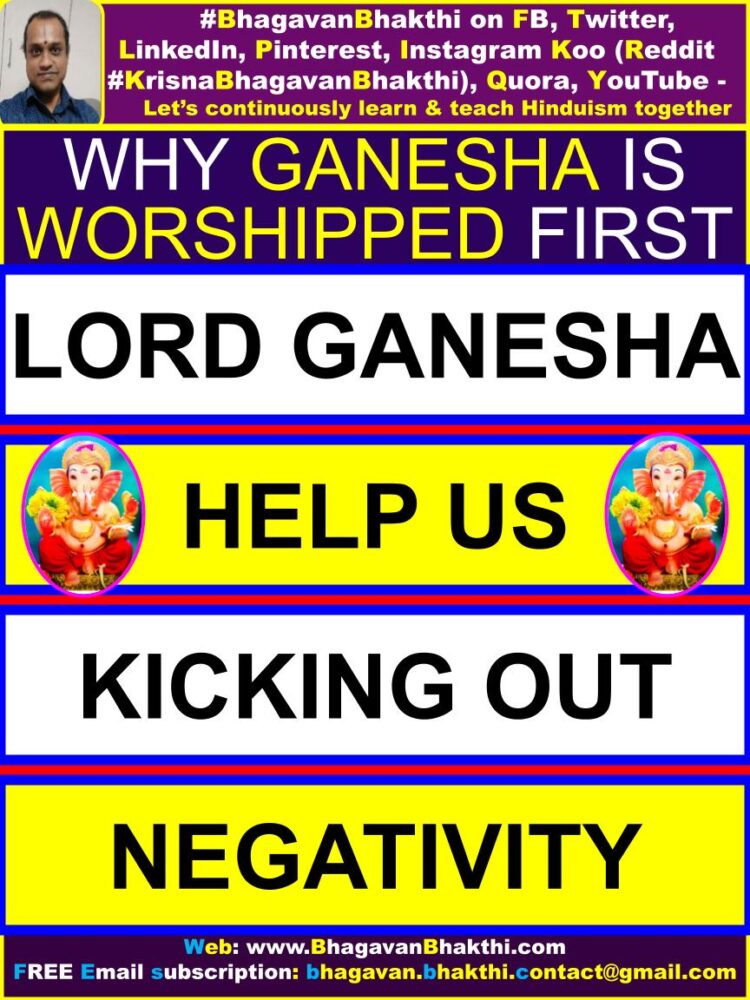
Lord Ganesha as Vighneshwara, that is, the Lord of Vighnas (alienating obstacles), Lord Ganesha is the controller of all obstacles and destroyer of miseries of his devotees.
Lord Ganesha is known as ‘Kshipra Ganapati‘, that is, someone who grants wishes of his devotees very quickly (here Kshipra means fast). Lord Ganesha is also called as ‘Vamana‘, as Lord Ganesha is depicted as a dwarf Devata. Here Vamana has the meaning ‘dwarf‘ in English.
Also Lord Ganesha is a form of fatty figure with pot belly, elephant head, large ears, small eyes, long nose and mouse as his vahana (vehicle). If we think this as an artistic angle, this figure of Lord Ganesha is most enchanting and blissful.
But behind this unique symbolism, hidden is a great philosophical secret, a moral, a management principle and a lesson for everybody to learn in life. Symbolism of Lord Ganesha is an embodiment of wisdom and a visible representation of the highest reality.

Now let us know how Lord Ganesha got the blessings of getting worshipped ‘first’:
Lord Ganesha born as the son of Sri Parivati Devi (Lord Ganesha birth as per Skanda Purana):
As per Skanda Purana (it is considered as a ‘Tamasa Purana‘), Sri Parvati got Lord Ganesha out of her body’s mud. But here we should understand the correct and real meaning of this story and we must not take the story as it is, as it gives a wrong image of Sri Parvati Devi.
As per Skanda Purana, when Sri Parvati Devi made the rachana / creation of Lord Ganesha out of her body’s clay, does it mean that she had lot of clay / mud on her body? How that much of clay / mud can come to her body? These are the few questions which appears in the mind of today’s liberals.
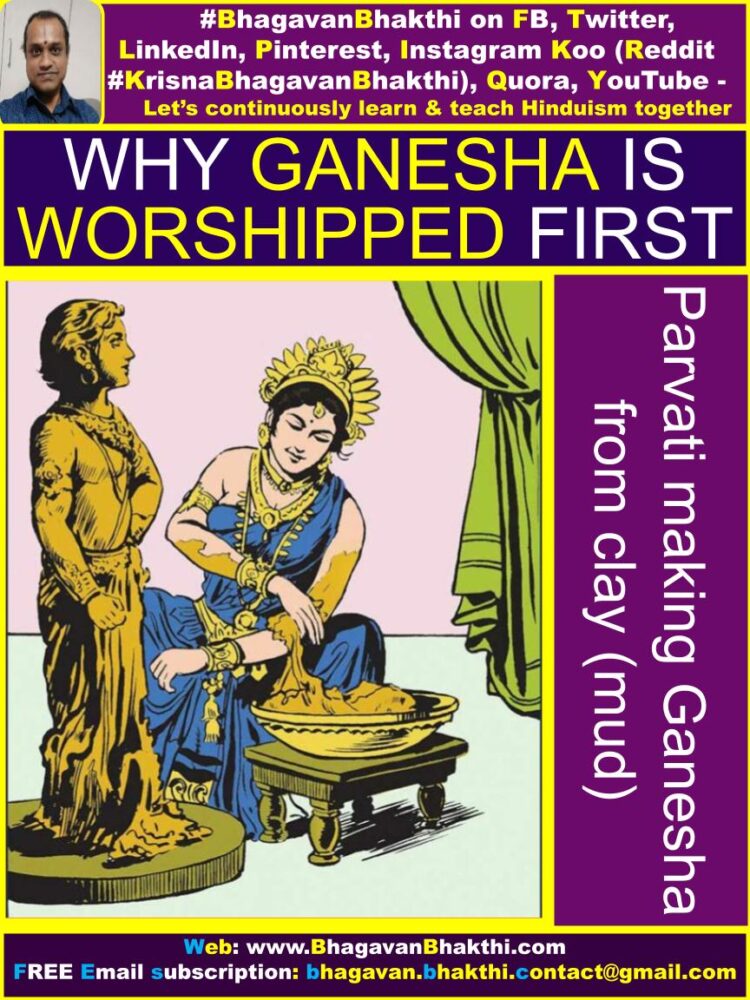
Let us go little back: When Sri Parvati Devi was born as “Sri Sati Devi“, that is, the daughter of Daksha Prajapati (thus Sri Sati Devi is also called as Dakshayani), Sri Sati Devi had created agni / fire out of her body and entered fire. So this means her body was full of agni / fire.
No right? Similarly, Sri Parvati Devi took out small portion of ‘Prithvi amsha‘, that is clay / mud out of her body. Sri Parvati Devi herself cannot create a son. Sri Parvati Devi cannot by herself can give birth to a child alone without the support of her sangati / partner.
A Woman without the support and anugraha (blessings) of her partner / Purusha, cannot produce a child and such things are not found anywhere.
We must understand that Sri Parvati Devi created Lord Ganesha only out of the grace, that is, anugraha / blessings and support of her husband Lord Shiva, but not on her own power. Ultimately it was the wish of Lord Sri Maha Vishnu.
Lord Sri Maha Vishnu wanted to give a Devata (Demigod), to whom the first pooja / worship to be done. Thus, with the wish of Bhagavan Sri Maha Vishnu, Sri Parvati Devi using the clay / mud gave birth to Lord Ganesha.
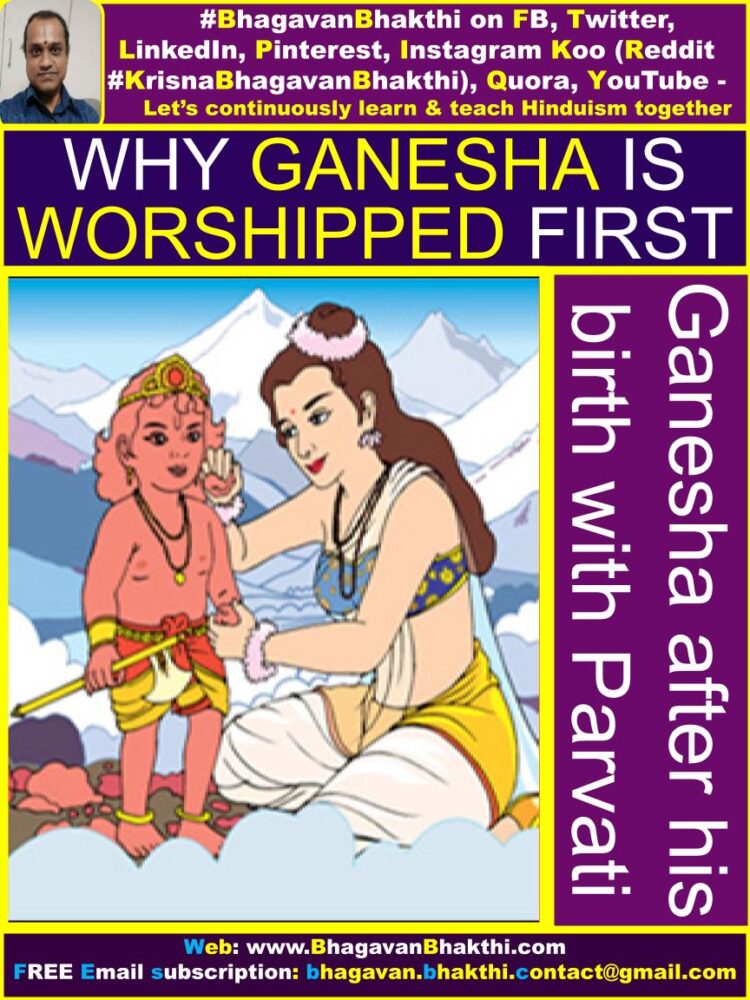
Lord Ganesha birth as per Brahma Vaivarta Purana : As per Brahma Vaivartha Purana (it is considered as a ‘Rajasa Purana‘). As per this Purana, Sri Parvati Devi was wanting to have putra / son. Thus Sri Parvati Devi did the tapas / penance for Lord Sri Maha Vishnu.
After some while, Bhagavan Sri Maha Vishnu blessed her to get a putra / son as per her wish. Once when both Lord Shiva and Sri Parvati Devi were in the intimate position, few Rishis / sages came to meet the couple and wished to get bhiksha (alms) from them.
Because of this, Sri Parvati Devi left Lord Shiva in the middle of their intimacy, so that she can arrange for the bhiksha (alms). Thus, in the meantime the veerya of Lord Shiva which had to be deposited inside Sri Parvati Devi fell on the ground.
With this veerya, a handsome and beautiful putra / son was born to Lord Shiva and Sri Parvati Devi. The same putra / son was none other than Lord Ganesha. Thus we should familiarize that, Lord Ganesha was born with the anugraha / blessings of Lord Shiva himself.
NOTE: We should note that both the Puranas were written by Sage and Lord Sri Veda Vyasa Ji (He is an avatar of Bhagavan Sri Maha Vishnu).
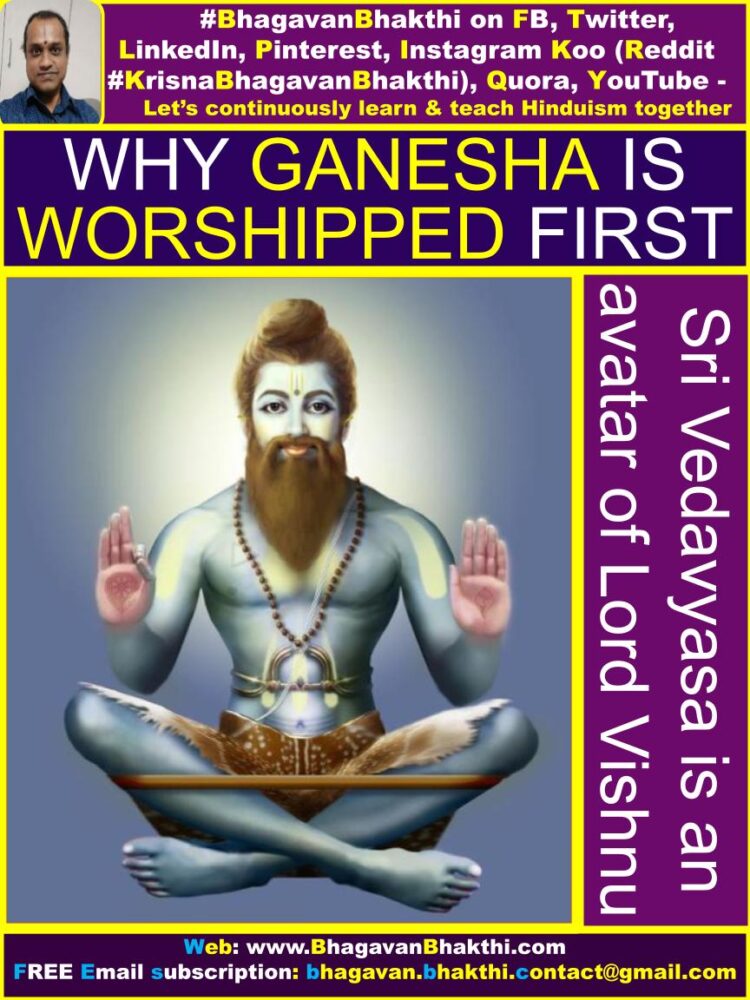
The difference is because, Skanda Purana story is a ‘Tamasa story‘. This is a ‘mohakaprada katha‘, that is, to produce illusion in the asura / demonic type of people, this Skanda Purana’s story was written.
How did Lord Ganesha got the head of an elephant? – Here also there are two versions of the story.
What does the Skanda Purana say about the Lord Ganesha’s elephant head?
This is very famous story and most of you must be aware of:Once Sri Parvati Devi went to take bath and made Lord Ganesh using the clay / mud and informed him to safeguard as a security at the main gate of the Sri Parvati Devi’s house.
At that very moment Lord Shiva who was thirsty comes to house where Lord Ganesha was safeguarding the gate of the house. Seeing Lord Shiva, Lord Ganesha stopped Lord Shiva. After lots of discussions, Lord Shiva looses his temper and out of anger, removes the head of Lord Ganesha.
Thus, after Sri Parvati Devi comes out and she sees the dead body of her beloved son and begged Lord Shiva to give life to him immediately.
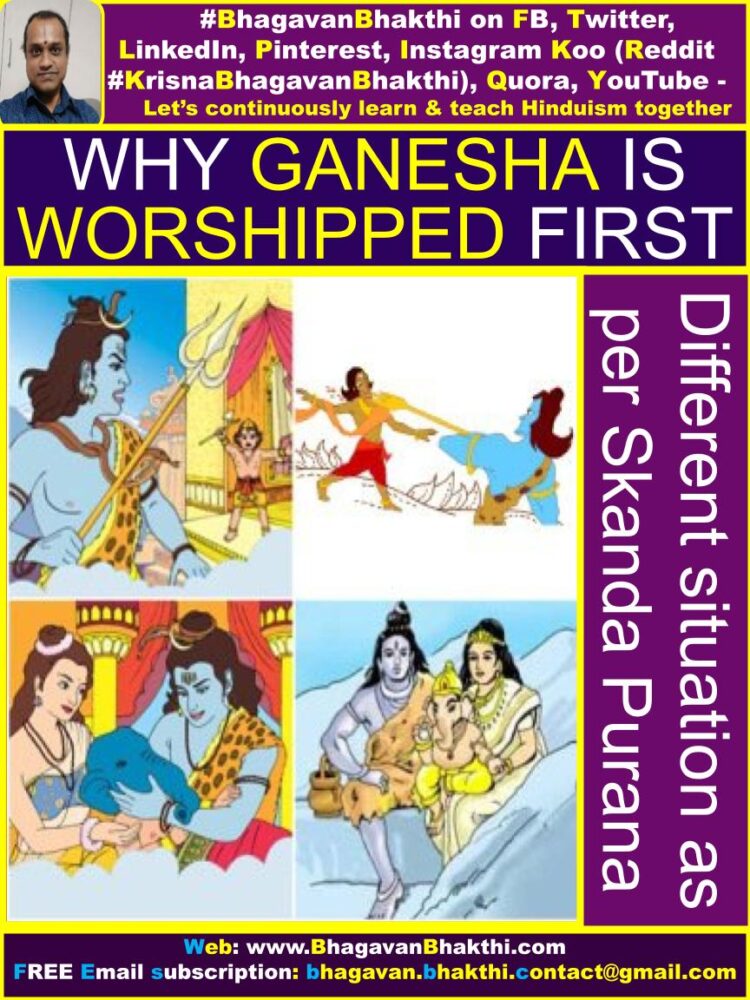
Lord Shiva in turn, then realizes that Lord Ganesha was his own son, and orders his ganas / servants to bring the head of anyone who is lying with the head towards north direction. The ganas / servants saw no one sleeping with head towards North and at the end found an elephant sleeping towards north direction.
Thus those ganas / servants cut off the head of that elephant and gives it to Lord Shiva. Soon Lord Shiva places the elephant head on the body of Lord Ganesha and brings back to Lord Ganesha to life again.
This is the story which many of you know. Usually, you would have seen on the television and movies too.
Now, what does the Brahma Vaivarta Purana say about the Lord Ganesha’s elephant head
As per the Brahma Vaivartha Purana, the story is completely different as given below:
As per the Brahma Vaivarta Purana, Lord Ganesha was very beautiful and handsome child. All the Devatas / Demigods, Rishis wanted to have his a darshana (a glimpse) of Lord Ganesha.
Everybody came to Lord Shiva home land, that is, Mount Kailasa (Kailash) to have a darshan (a divine glimpse) of Lord Ganesha and were praising the Lord Ganesha. Sri Parvati Devi was very much happy as she had given birth to a beautiful and handsome son.
[Note : There is a temple of Lord Ganesha in Koothanu, Tamil Nadu with human head called as ‘Aadhi Vinayakar’ (Original Ganesha).]

After many Devatas (Demigods) came to Lord Ganesha, similarly Lord Shanaischara (Lord Shani Deva), also comes to see Lord Ganesha. But Lord Shani Deva was little hesitating to see Lord Ganesha and thus was sitting outside.
Sri Parvati Devi realizing this, asked Sri Shani Deva to come inside and have the darshan (a divine glimpse) of Lord Ganesha. Lord Shani Deva told Sri Parvati Devi, that, he is having a curse from his wife ‘Manda’ that, if he sees anybody directly his head would be cut off.
(The story of this is that, once Sri Shani Deva was doing Dhyana / meditating of Lord Sri Vishnu. At that time very time his wife Manda, the daughter of Chitraratha, came in front of him. But Sri Shani Deva who was in dhyana / meditation did not see her at all.)
(Thus, Manda cursed Sri Shani Deva that whoever Sri Shani Deva sees directly would get his head cut off immediately).
This was the story of Sri Shani Deva and his wife Manda – One the other hand, Sri Parvati Devi compels Sri Shani Devi to have a darshan (a glimpse) of her son Lord Ganesha. Thus after a long compellation, Lord Shani Deva agrees to see Lord Ganesha.
As soon as Lord Shani sees Lord Ganesha directly, Lord Ganesha’s head gets cuts off from his body. Thus, Sri Parvati Devi now repents for having forced Sri Shani Deva to see his beautiful and handsome putra / son and she starts to cry.
This is the original story as per the Brahma Vaivarta Purana, on how Lord Ganesha looses his head.
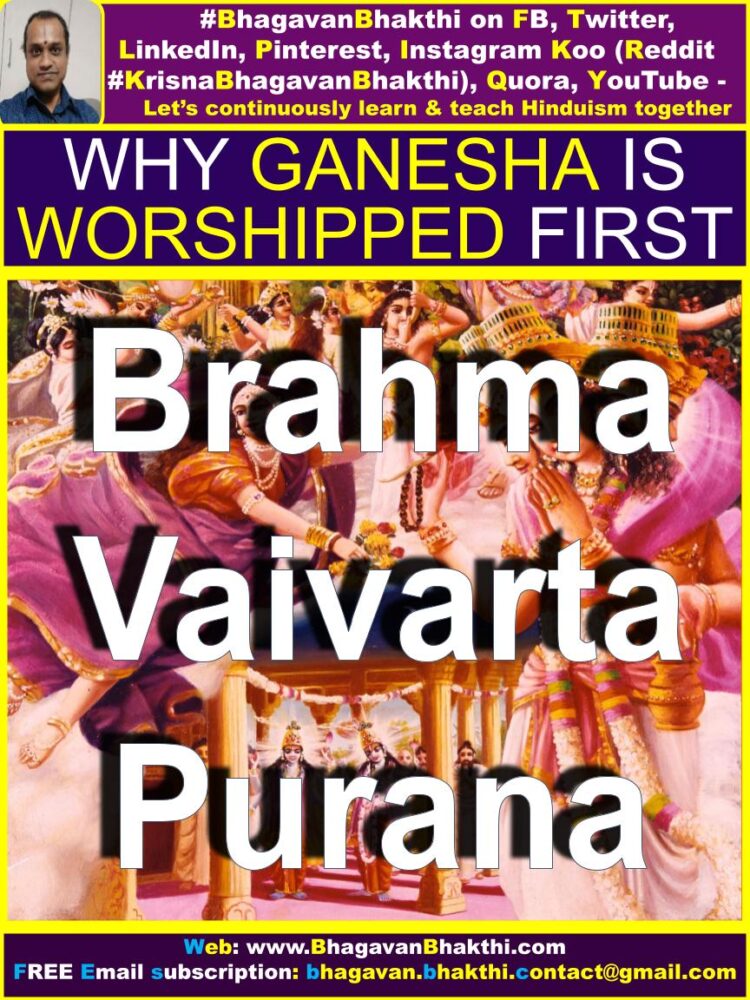
The great Vaishnava saint who is the avatar of Sri Vayu Deva, that is, Sri Madhvacharya Ji in his ‘Manduka Upanishat Bhashya‘ has given explanation about how Lord Ganesha got the elephant’s head.
As per Sri Madhvacharya Ji, Lord Ganesha is the aradhaka (worshipper) of Bhagavan Vishva and Taijasa roopas / forms of Lord Sri Maha Vishnu. Both (that is, Vishva and Taijasa forms) are Jagrat and Svapnavasta niyamaka roopas / forms – i.e., ‘Vishvambhara roopa / form‘.
(Same roopa which Lord Sri Krishna shows to Arjuna during the Bhagavad Gita pravachana).
This form of Lord Sri Maha Vishnu has 19 heads in total. The Central head is of Gajamukha (Gajamukha – Gaja = elephant, mukha = head), whereas the other 18 faces are human faces.
Lord Ganesha was doing the chintana (thinking) of “Vishvambara roopa” of Lord Sri Maha Vishnu. Thus Lord Ganesha got the Gajamukha (elephant’s head).
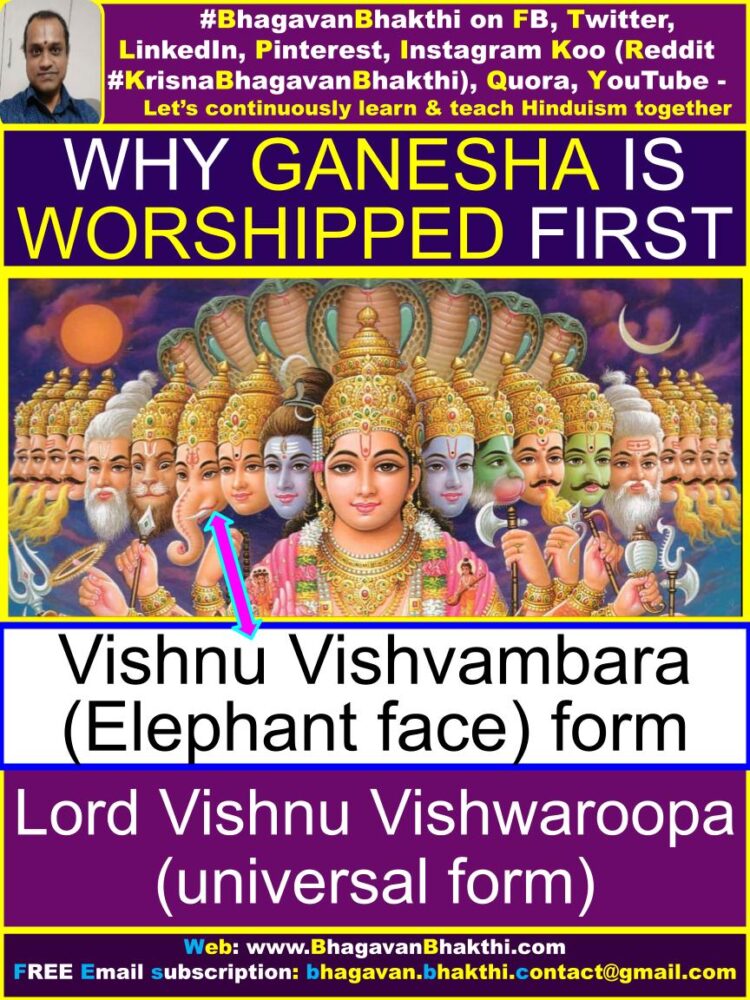
(We should always remember that, what we think in our mind, so will Bhagavan Sri Maha Vishnu will give us the blessings as per our mindful thought. If we think Lord Sri Krishna is an ordinary human, we will be very ordinary human.)
(And if we think Lord Sri Krishna is svayam Bhagavan, we will get the blessings as per our bhakti / devotion.)
Thus, Sri Parvati Devi prayed Lord Sri Maha Vishnu who immediately rushed there. Lord Sri Maha Vishnu went and removed the head of an elephant which was sleeping it’s head facing towards North.
Now naturally we will get a question in our mind that “Why Lord Sri Maha Vishnu brought the head of an elephant and placed it on Lord Ganesha and not of any other animal or humans“:
Now let us get the clarification on this as per the Brahma Vaivarta Purana:
Once the great Rishi Durvasa (He is an avatar of Lord Shiva) gave the ‘Nirmalya‘ (Remains of an offering to a deity, e.g., flowers etc. – here of Lord Sri Maha Vishnu) of Lord Sri Maha Vishnu to Lord Sri Indra Deva.
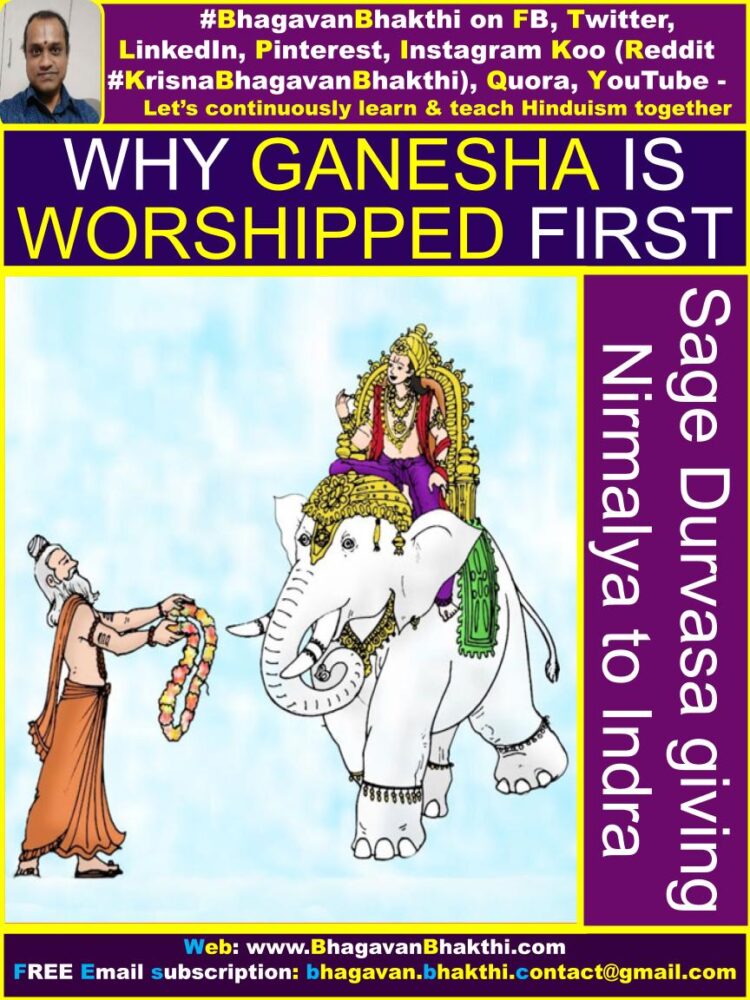
Lord Sri Indra Deva in turn put it on the head of an elephant, but this elephant threw it and touched with its legs. Since, that elephant had neglected Nirmalya (remains of an offering to a deity – here of Lord Sri Maha Vishnu) of Lord Sri Maha Vishnu,
Lord Sri Indra Deva got so many problems and he had to loose his Indrapadavi (loosing the power of being the king of heaven) also. After Samudra Manthana (churning of ocean) and after getting ‘Amrita‘ (ambrosia), Sri Indra Deva got back his power.
Now the point to be noted is, here that particular elephant which touched the ‘Nirmalya‘ (remains of an offering to a deity – here of Lord Sri Maha Vishnu) of Lord Sri Maha Vishnu with its legs got the sin.
Thus, that elephant had to be punished. Bhagavan Sri Maha Vishnu removed the head of that particular elephant as a punishment and attached it to Lord Ganesha.
Here we should also note that, since that particular elephant was lucky to have the sparsha (touch) of ‘Hari Naivedita Nirmalya‘ (Naivedya food of Bhagavan Sri Maha Vishnu) and as such, that particular elephant’s head could become the head of Lord Ganesha.
This is the original story as per the Brahma Vaivartha Purana.
(We should always keep in mind that, Lord Sri Maha Vishnu will always be keeping a watch on everyone. If we do good Karmas, we will get the good fruits. Similarly, if we do bad Karmas, we will definitely get the fruits as per our Karmas. “Jaise Karni, Vaise Bharni“).

Naming ceremony (Namakaranam) of Lord Ganesha story is as given below:
Goddess Sri Parvati Devi requested Lord Sri Maha Vishnu to name her child.
Thus Lord Sri Maha Vishnu himself gave 8 auspicious names of Lord Ganesha as given below:
8 auspicious names of Lord Ganesha is as given below:
1. Vighnesha (Vighnesh) – He is the one who is the pariharaka / remover of obstacles. | 2. Ganesha (Ganesh) – He is the head of all the Ganas including Nandi and Bhrungi. | 3. Heramba (Heramb) – He fought with Lord Shiva. |
4. Gajanana (Gajanan) – He has the head of an elephant (also known as Gajamukha). 5. Lambodara (Lambodar) – He has big fat udara / stomach. |
6. Shurpakarana (Shurpkarna) – He has broad ears. | 7. Vinayaka (Vinayak) – He is always immersed in the dhyana / meditation of Lord Sri Maha Vishnu. | 8. Ekadanta (Ekadant) – He has one tusk.
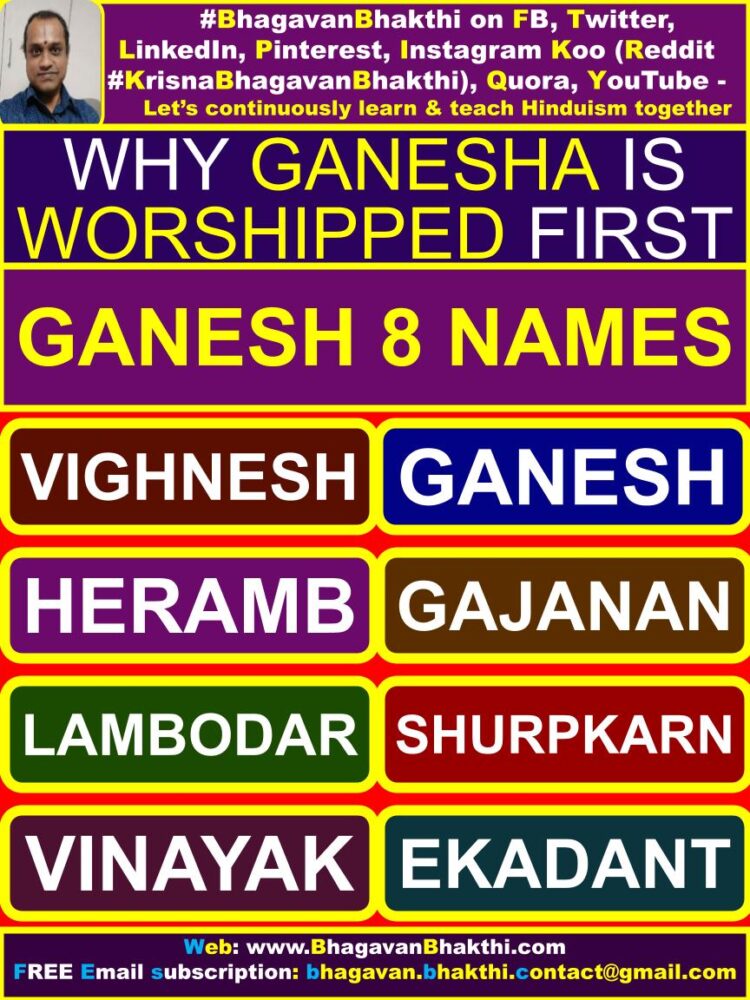
Now, let us know different names of Lord Ganesha, which are known as “Ganesha Dvadasha naama” (Lord Ganesha’s twelve names):
Twelve (Dwadasha) (12) important names of Lord Sri Ganesha are as below:
These are known as ‘dvadasha namam‘ (12 names):
1. Sumukha: Sri Ganesha is called as Sri Sumukha, as he is so beautiful even Lord Sri Chandradeva is nothing in front of him. Sumukha = Su = Beautiful, very beautiful / mukha = face, body.
2. Ekadanta: Since Sri Ganesha has only one tooth, he is known as Sri Ekadanta. To write Sri Mahabharata, Bhagavan Sri Vedavyasa Ji appoints our Sri Ganesha. Just before starting to write, Sri Ganesha would not be having the pen.
For this reason, Sri Ganesha plucks out his one tooth and uses it as the pen. Thus Sri Ganesha is also known as Sri Ekadanta. Ekadanta = Eka / Ek = One, danta = danta / tooth.
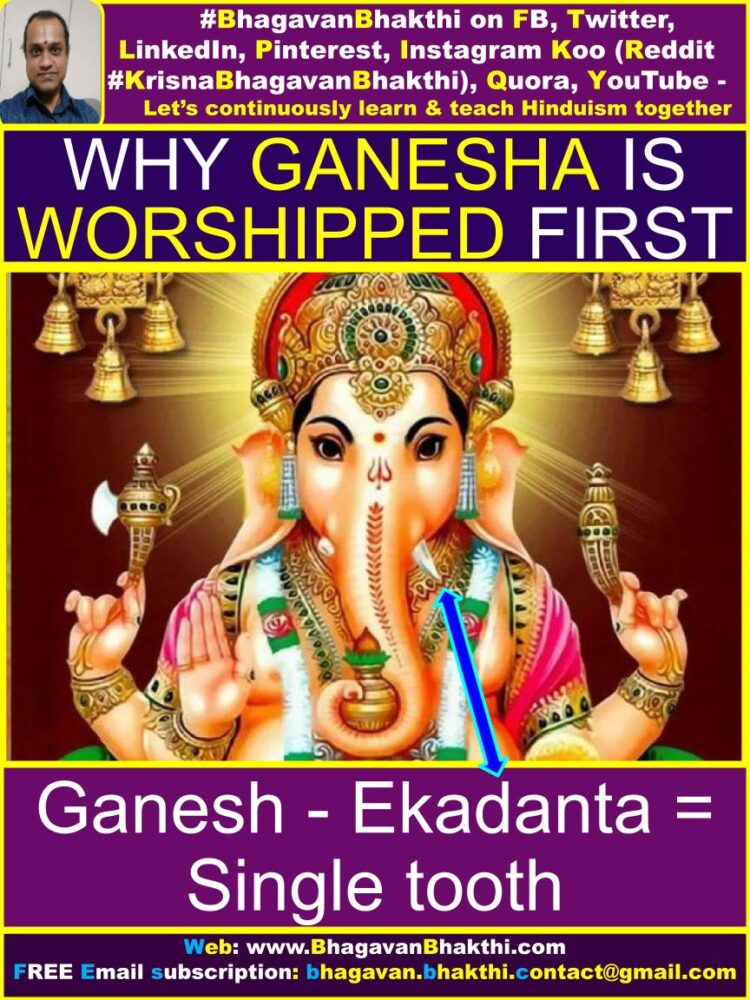
3. Kapila: Sri Ganesha is known as Sri Kapila. Sri Ganesha’s body colour is red. In Samskruta / Sanskrit, Kapila means red. Thus our Sri Ganesha got the name as Sri Kapila. Also, since Sri Ganesha’s body colour is red, he is called as Sri Raktavarna.
In Samskruta (Sanskrit), rakta means blood, which is red in colour and thus is the name.
4. Gajakarnaka: Sri Ganesha’s another name is Sri Gajakarnaka. Since our loving Lord Sri Ganesha is having ears like that of the elephant, He is known as Sri Gajakarnaka. Gajakarnaka = Gaja = Gaja / Gaj / Elephant, Karnaka = Karna = ear, ka = having.
5. Lambhodhara: Ours Sri Parvati Shiva’s son Sri Ganesha likes modaka / modak, chakkali, nippattu etc very much. Thus his tummy is little bigger. For this reason, He is known as Sri Lambhodhara. Lambhodhara = Lambo + udhara. Lambo = Big, udhara = udhara / udhar / tummy.
6. Vikata: Sri Ganesha likes to be happy always. The Ganas who stay with Him are always kept happy by Sri Ganesha. Thus Sri Ganesha is known as Sri Vikata.
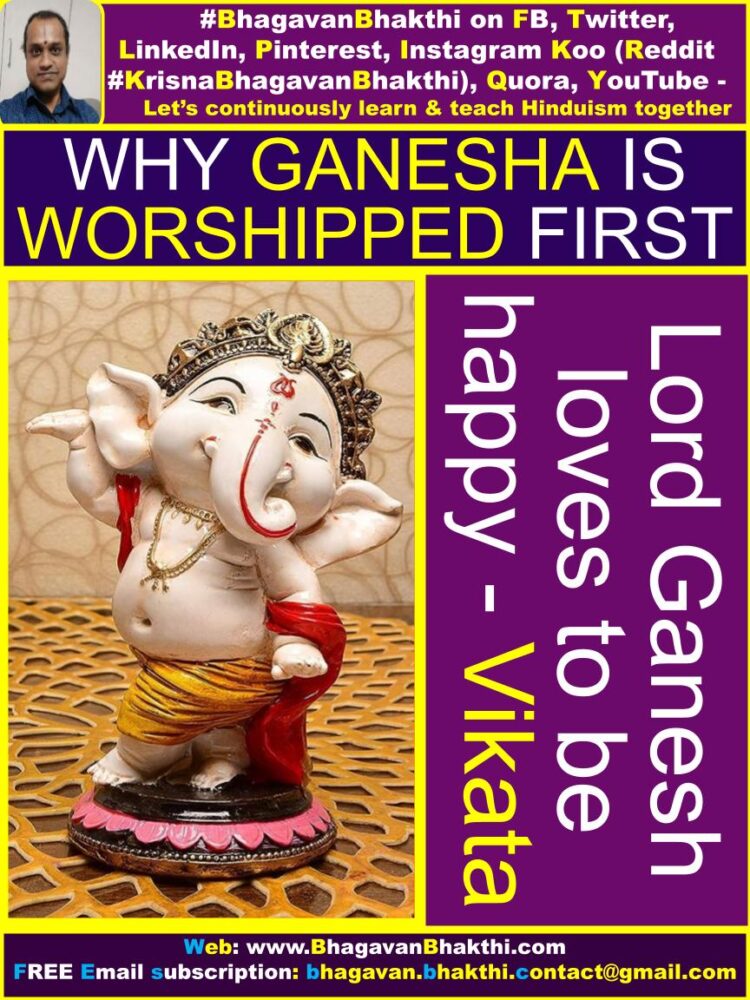
7. VighNanashaka: Sri Gowri son’s another name is called as Sri VighNanaashaka. With the blessings of Sri LakshmiNarayana, all the obstacles are destroyed by our Sri Ganesha. Thus the name. VighNanashaka = VighNa + nashaka = VighNa = Obstacles, nashaka = destroyer.
8. VinAyaka: Sri Skanda brother’s name is Sri Vinayaka. Our Sri Ganesha is very polite and whoever believes / follows Him, even that person will by made polite by our Sri Ganesha.
Thus the name Sri Vinayaka for our Sri Ganesha. Vinayaka = Vinaya + nayaka, vinaya = politeness, nayaka = king / giver of politeness.
9. DhumravarNa: Sri Ganesha likes the smoke that effulgence (spreads) during the pooja and also his body colour is illuminated with smoke. Thus the name. DhumravarNa = Dhuma + varNa, Dhum = Dhum / Dhupa / Dhup, varNa = body colour.
(Sri Ganesha also has the name Sri Kapila. Devatas / Demigods are not similar to humans as they can do anything with the blessings of Sri Hari).
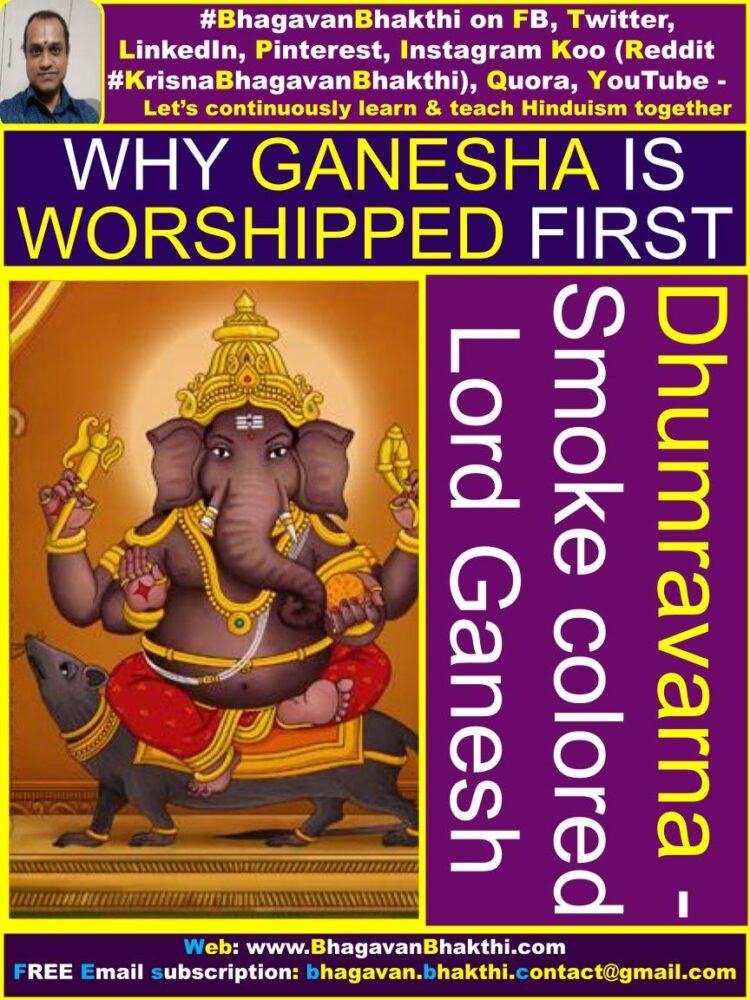
10. GajAdhyeksha: Sri Ganesha is known as Sri GjAdhyeksha. Our Sri Ganesha is king, leader of all the gaja / gaj / gaNa / gaN. Thus the name. GajAdhyeksha = Gaja + adhyeksha, gaja = gaja / gaj / gaNa / gaN, adhyeksha = adhyeksha / adhyeksh / king / leader.
11. BAlachandra: Our loving, Sri Ganesha is known as Sri BAlachandra. Sri Ganesha is very loving son of his father Sri Shiva and mother Sri Parvatidevi and similar to His father Sri Ganesha also wears the Lord Sri Chandra on his forehead. Thus the name Sri BAlachandra.
BAlachandra = BAla + chandra, BAla = son, Sri Shiva and Sri Parvati’s son, chandra = He is similar to Lord Chandradeva and also He wears the Lord Chandra on his forehead.
12. GajAnana: Sri Ganesha’s another prominent name is Sri GajAnana. Sri Ganapati is having this name since his face is similar to gaja / gaj / elephant. GajAnana = Gaja + anana, gaja / gaj = elephant, anana = countenance / having face.
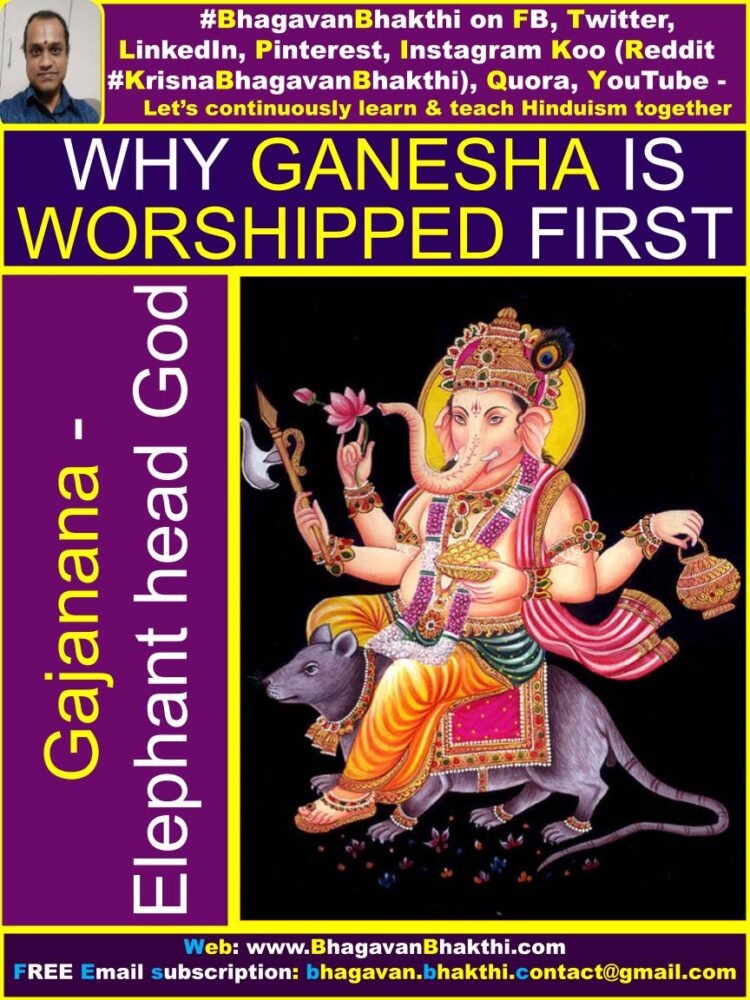
Continue reading about Lord Ganesha – Lord Ganesha information, facts, significance, importance etc.
More information will be added to his post (article) on regular basis. Please visit again to know the updated information after some time.
Let’s know more info about Hinduism (Sanatana Dharma) and Bhagavan Lord Sri Krishna (Vishnu) by clicking the below link:
Hinduism (Sanatana Dharma) information, facts, etc.
Lord Sri Vishnu stories, information, facts, significances, etc.
About Bhagavan Lord Sri Krishna
List of demons killed by Lord Krishna
Continue reading about Hinduism (Sanatana Dharma) :
Rivers information in Hinduism (Sanatana Dharma)
Mahabharata information, facts, significance, importance etc.
Ramayana information, facts, significance, importance, etc.
To watch, “When was Hinduism (Sanatana Dharma) was started“, please click the below YouTube video link:
To watch videos on #Hinduism #Sanskrit language, SUBSCRIBE to my YouTube channel from this below link:
#BhagavanBhakthi YouTube channel
Dear friends, if you need any clarifications about this post, kindly let me know, I will definitely try to answer all of them.
Also your one LIKE, one COMMENT, One Share, one SUBSCRIPTION is highly important.
This will help to know the quality of this content and also it will be helpful to know if any improvements is required for the content.
If you feel this content is useful to you and has helped you to improve your knowledge, kindly share this with your well-wishers.
Because “SHARING MEANS CARING”.
For receive FREE EMAIL SUBSCRIPTION about #BhagavanBhakthi, you can send an email to bhagavan.bhakthi.contact@gmail.com from your email ID.
NAMASTE!
SRI GURUBHYO NAMAHA
OM NAMO NARAYANAYA
Sri Krishnaarpanamastu
Subscribe / Follow us Share in Social Media